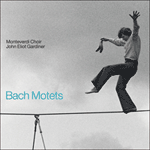The eight-part
Fürchte dich nicht has been assigned to the funeral service of the wife of the Leipzig official Stadthauptmann Winkler on 4 February 1726. The work is in two movements. The first, a setting of Isaiah 41, verse 10, uses a modernized version of the late sixteenth-century polychoral style, with the two choirs answering and combining largely in block chords. Exactly half way through the work the text changes to Isaiah 43, verse 1, set to a three-part chromatic fugue sung by the combined lower voices of the two choirs, which then supports two verses of Paul Gerhardt’s hymn ‘Warum sollt ich mich denn grämen’, given out as a cantus firmus by the combined sopranos. Of the six Bach motets, this is the one most closely related in style to the motets of the earlier members of his family; indeed, it has exactly the same formal scheme as the eight-part setting of ‘Fürchtet euch nicht’ by Johann Michael Bach (1648–94), a work that Bach would have known from a copy in the archive of his family’s compositions, which he helped to assemble.
from notes by Peter Holman © 1990
Le motet à huit parties
Fürchte dich nicht a été assigné au service funèbre de l’épouse d’un autre fonctionnaire lipsien, le Stadthauptmann Winkler, le 4 février 1726. Il s’agit d’une œuvre en deux mouvements. Le premier, une mise en musique du verset 10 d’Isaïe 41, recourt à une version modernisée du style polychoral de la fin du XVIe siècle, avec les deux chœurs qui se répondent et se combinent essentiellement en blocs d’accords. Pile à la moitié de l’œuvre, le texte passe au verset 1 d’Isaïe 43, exprimé sur une figure chromatique à trois parties chantée par une combinaison des voix inférieures des deux chœurs et qui soutient deux versets de l’hymne de Paul Gerhardt, «Warum sollt ich mich denn grämen», énoncés en cantus firmus par les sopranos combinées. De nos six pièces, celle-ci est l’une des plus apparentées, stylistiquement, aux motets des ancêtres de Bach: son schéma formel est exactement celui du «Fürchtet euch nicht» à huit parties de Johann Michael Bach (1648–1694), une œuvre que Johann Sebastian connaissait grâce à un exemplaire conservé dans les archives des compositions familiales, qu’il avait contribué à réunir.
extrait des notes rédigées par Peter Holman © 1990
Français: Hypérion
Das achtstimmige
Fürchte dich nicht, welches für das Begräbnis der Frau eines weiteren Leipziger Amtsträgers, Stadthauptmann Winkler, am 4. Februar 1726 entstand, hat eine zweisätzige Anlage. Der erste Satz ist eine Vertonung von Jesaja 41, 10, wobei eine modernisierte Version des mehrchörigen Stils des 16. Jahrhunderts verwendet wird, in dem die beiden Chöre, zumeist in Akkordblöcken, einander antworten und sich zusammentun. Genau in der Mitte des Werks wechselt der Text zu Jesaja 43, 1, der zu einer dreistimmigen chromatischen Fuge erklingt, die von den tiefen Stimmen beider Chöre unterhalb des Cantus firmus—„Warum sollt ich mich denn grämen“ von Paul Gerhardt—der kombinierten Sopranstimmen gesungen wird. Von den sechs Bach-Motetten liegt diese stilistisch am nächsten derjenigen seiner Vorfahren; tatsächlich hat sie genau die gleiche formale Anlage wie die achtstimmige Vertonung von „Fürchtet euch nicht“ von Johann Michael Bach (1648–94), ein Werk, das Bach von einer Kopie des Familien-Notenarchivs, welches er selbst mit zusammengestellt hatte, her kannte.
aus dem Begleittext von Peter Holman © 1990
Deutsch: Viola Scheffel


 Bach: Motets
Bach: Motets Bach: Motets
Bach: Motets
